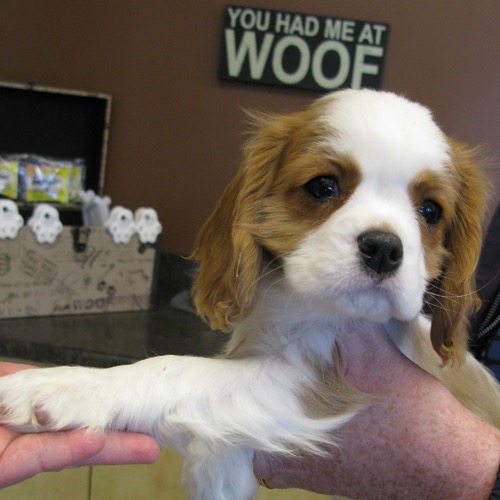AKC's National Cavalier Breed club (ACKCSC) established the breed specific testing protocols. Dogs complying with the breed specific testing requirements are issued a CHIC number by the Orthopedic Foundation for Animals (OFA). The ACKCSC requires that to qualify for a Certification the Eye Examination is by a Board Certified American Veterinary (ACVO) Opthalmologist.
Initial exam 8-12 weeks
1 Year Follow up
2-5 years of age Annually
6+ Every two years until age 9 unless breeding then annually
It does NOT require that the results of the examinaion show no eye disorders. Therefore it is up to the discretion of the puppy buyer to actually look to make sure the breeder has NOT bred an inherited disorder.
Dogs with Cataracts, Geographical Retinal Dysplasia, Etropian and Dry Eye should never be bred.
About 30% of Cavaliers are afflicted with eye disorders ranging from mild to serious eye problems.
The following information is listed by the ACVO as eye conditions that occur in the Cavalier is high enough percentages to be considered of concern to the breed. Some of the conditions are listed as 'breeder option' to use a dog diagnosed with the condition as the hereditary links are not established. Where they are listed as NO means the dog is affected and should NOT be bred.
CATARACTS - there are two types; early onset- juvenile cataract which appear by 6 months of age and will progress to total blindness by 2-4 years of age. This can normally be caught at the 8-12 week exam. Age related cataracts such as from diabetes or prgressive retinal atrophy (PRA). Can NOT be bred.
CORNEAL DYSTROPHY- is a genetic disorder which is quite common in Cavaliers. It is the development of a gray-white opaque deposits of calcium and fats under the surface of both the dog's corneas. The will appear around the age of 2 and 4 and can come and go. Corneal dystrophy does not affect vision, is not painful and no treatment is necessary. Interestingly that bitches that have had Corneal Dystrophy prior to being bred often test normal after whelping and nursing a litter of puppies. Some changes in food and diet can also reduce or increase the size of the deposits. It is a Breeder Option
DISTICHIASIS - is the growth of extra eyelashes (cilia) can cause serious irritation, tearing and corneal abrasions and ulcerations that are extremely painful. Treatment is to surgically correct and remove the eyelashes and kill the hair follicles to stunt regrowth. Currnetly the ACKCSC classifies this as Breeder Opition however the Canine Inherited Disorders Database reccomends that CKCSC affected with Distichiasis NOT be bred.
ETROPIAN - is the inward rolling of the eyelid edges and normally affects the lower eyelid. The hair on the affected lid continuously rubs the cornea and causes significant pain and trauma to the cornea resulting in blindness if untreated. Currnetly the ACKCSC classifies this as Breeder Opition however the Canine Inherited Disorders Database reccomends that CKCSC affected with Distichiasis NOT be bred.
MICROPHTHALMIA - an inherited defect which is particularly common in the CKCSC where one or both of the eyes is smaller than normal. This has restriction of vision and often blindness. NOT be bred.
RETINAL DYSPLASIA - is a malformation of the retina. It occurs when the two layers of the retina do not lay properly where 'folds' in the inner layer called retinal folds form. These folds can be seen on the 8 - 12 week exam and often flatten out only to re-appear later in life. Single or intermitten Retinal folds represent small blind sots which normally do not affect the dog's vision. Single or intermitten folds in CKCSC is a breeder Option.
Geographical folds which can cause larger defects in the visual field and retinal detachments where complete blindness can occur. Dr. Sheila Crispin states that MRD is commonly found in the CKCSC. Allowing single folds to be bred potentially results in Geographical folds to be brough fowrard in subsiquent generations. Only Geographical Retinal Dysplasia is NOT to be bred.
Unfortuntaly, there are several (ACVO) Opthalmologist that do not believe that Geographical folds will not have detrimental affects on Cavaliers and will pass Geographical folds.
DRY EYE SYNDROME - is a painful genetic disorder where itis estimated that over 12% of CKCSC are at risk. Dry Eye is the inflammation of the cornea and conjunctiva due to the inability to produce tears. It can not be cured. Dry Eye requires frequent medication daily. High hereditary factor in as a bitch with Dry Eye can produce an entire litter of affected puppies that are symptomatic by age 8 weeks. Early treatment of Dry Eye is crucial to prevent corneal destruction and infection which leads to blindness. Not listed by the ACKCSC however should NOT be bred.
